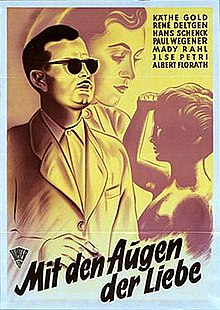| Eyes of Love | |
|---|---|
 | |
| Directed by | Alfred Braun |
| Written by |
|
| Produced by |
|
| Starring | |
| Cinematography | Reimar Kuntze |
| Edited by | Walter Fredersdorf |
| Music by | Wolfgang Zeller |
Production company | |
| Distributed by | Imperial Film |
Release date |
|
Running time | 99 minutes |
| Country | West Germany |
| Language | German |
Eyes of Love ( German: Augen der Liebe) is a 1951 West German drama film directed by Alfred Braun and starring Käthe Gold, René Deltgen and Paul Wegener.
The screenplay was written by the director Veit Harlan. Harlan developed the project, but then turned over direction to his friend Braun.
The film was a wartime production, which began shooting in 1942 and was completed in 1944. Planned for a 1945 release, it was blocked by Joseph Goebbels who found the quality poor and disliked the fact that much of it was set in hospitals. It was eventually given a belated post-war release in 1951. By the time it was released, several of its cast members had died. [1]
The film's sets were designed by the art directors Wilhelm Depenau and Alfred Tolle.
- Käthe Gold as Schwester Agnes
- René Deltgen as Günther Imhoff
- Paul Wegener as Prof. Mochmann
- Hans Schlenck as Dr. Lamprecht
- Ilse Petri as Milo Thiele
- Rudolf Schündler as Dr. Bertram
- Mady Rahl as Gerda Schirmer
- Albert Florath as Laboratoriumsdiener
- Maria Koppenhöfer as Oberschwester
- Gertrud Spalke
- Marina Werner-Papke
- Walter Pentzlin
- ^ Noack p.248
- Noack, Frank. Veit Harlan: The Life and Work of a Nazi Filmmaker. University Press of Kentucky, 2016.
- Eyes of Love at IMDb
| Eyes of Love | |
|---|---|
 | |
| Directed by | Alfred Braun |
| Written by |
|
| Produced by |
|
| Starring | |
| Cinematography | Reimar Kuntze |
| Edited by | Walter Fredersdorf |
| Music by | Wolfgang Zeller |
Production company | |
| Distributed by | Imperial Film |
Release date |
|
Running time | 99 minutes |
| Country | West Germany |
| Language | German |
Eyes of Love ( German: Augen der Liebe) is a 1951 West German drama film directed by Alfred Braun and starring Käthe Gold, René Deltgen and Paul Wegener.
The screenplay was written by the director Veit Harlan. Harlan developed the project, but then turned over direction to his friend Braun.
The film was a wartime production, which began shooting in 1942 and was completed in 1944. Planned for a 1945 release, it was blocked by Joseph Goebbels who found the quality poor and disliked the fact that much of it was set in hospitals. It was eventually given a belated post-war release in 1951. By the time it was released, several of its cast members had died. [1]
The film's sets were designed by the art directors Wilhelm Depenau and Alfred Tolle.
- Käthe Gold as Schwester Agnes
- René Deltgen as Günther Imhoff
- Paul Wegener as Prof. Mochmann
- Hans Schlenck as Dr. Lamprecht
- Ilse Petri as Milo Thiele
- Rudolf Schündler as Dr. Bertram
- Mady Rahl as Gerda Schirmer
- Albert Florath as Laboratoriumsdiener
- Maria Koppenhöfer as Oberschwester
- Gertrud Spalke
- Marina Werner-Papke
- Walter Pentzlin
- ^ Noack p.248
- Noack, Frank. Veit Harlan: The Life and Work of a Nazi Filmmaker. University Press of Kentucky, 2016.
- Eyes of Love at IMDb